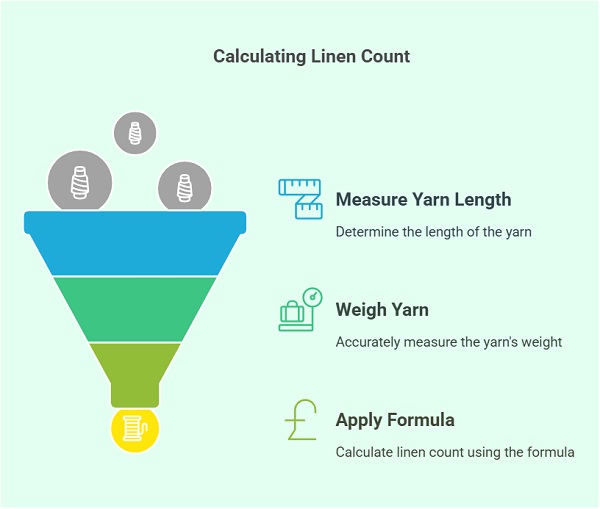Linen Count (Lea) Calculator
© Yarn Count Ltd. 2025. All Tools in the Yarn Count have been reviewed by the relevant spinning industry experts.
The formula for Linen Count (Lea)
Linen Count (Lea) = (Weight of yarn in grams × Ply)
Where:
- Weight of yarn in grams: The mass of the yarn you are working with.
- Ply: The number of strands of yarn twisted together to form the final yarn.
Table of Contents
What Is Linen Count (Lea)?
Linen count (lea) is a measurement that determines the number of hanks or lengths of yarn in one pound of weight. It is commonly used for linen and other coarse yarns in the textile industry. The higher the linen count, the finer the yarn. For example, a higher linen count indicates thinner, finer yarn, while a lower count corresponds to thicker yarn.
Linen count (lea) differs from other yarn counting methods, such as cotton count or wool count, due to its unique system of measurement. Understanding how to calculate and interpret linen count is crucial for professionals in textile engineering.
Importance of Linen Count in Textile Manufacturing
Linen count plays a critical role in determining fabric texture, durability, and weight. When choosing yarn for weaving or knitting, the linen count directly impacts the finished product’s characteristics. A proper linen count ensures that manufacturers can produce fabrics with the right feel and quality.
For example, in the production of linen fabric, the yarn’s fineness affects the smoothness and breathability of the fabric. If the yarn is too thick, the fabric may become rough and less comfortable. On the other hand, too fine a yarn can lead to a fabric that is too delicate for heavy usage.
How to Calculate Linen Count (Lea)?

The linen count is calculated based on the number of yards of yarn in a pound. The formula for linen count is:
Linen Count (lea) = Number of Yards / Weight in Pounds
This formula provides the number of yards of yarn in one pound, giving a direct indication of the yarn’s thickness. For instance, if a yarn has a linen count of 20, it means there are 20 yards of yarn in one pound of weight.
Here’s a step-by-step breakdown of the linen count calculation:
Step 1: Measure the Length of Yarn
The first step is to measure the length of yarn you want to calculate the linen count for. This can be done by using a measuring device such as a tape measure or a yarn counter.
Step 2: Weigh the Yarn
Next, weigh the yarn on a scale to determine its weight in pounds. This is important because the linen count formula is based on the weight of the yarn.
Step 3: Apply the Formula
Once you have the length and weight of the yarn, apply the linen count formula to calculate the linen count. Divide the number of yards of yarn by its weight in pounds to get the linen count.
Benefits of Using a Linen Count Calculator

A linen count calculator is an excellent tool for textile engineers and manufacturers because it simplifies the calculation process. Instead of manually calculating the linen count, which can be time-consuming and prone to errors, a calculator provides an instant and accurate result.
Additionally, a calculator can help standardize the measurements, ensuring that all calculations are consistent across production batches. This can improve the overall quality control in textile manufacturing and lead to better-quality fabrics.
Saves Time
With a linen count calculator, textile professionals can quickly determine the yarn’s thickness, which helps streamline the production process. This saves valuable time, particularly in large-scale manufacturing environments.
Increases Accuracy
Manual calculations are subject to human error, but using a calculator eliminates this risk. The tool ensures that every calculation is accurate, reducing the likelihood of mistakes that could affect fabric quality.
Enhances Fabric Quality
By using the correct linen count for a specific fabric, manufacturers can produce fabrics with the desired properties. Whether the goal is to create a lightweight, breathable fabric or a more durable, heavyweight material, the calculator helps achieve the perfect result.
Practical Applications of Linen Count
Linen count calculators are used in various textile production processes, including the creation of fabrics for clothing, upholstery, and home textiles. Understanding and applying the correct linen count can make a significant difference in the final product’s quality and performance.
Garment Manufacturing
In garment manufacturing, the linen count determines how soft or firm the fabric feels. For garments that require a softer texture, a higher linen count (finer yarn) is used. Conversely, for durable fabrics such as jeans or coats, a lower linen count (thicker yarn) is preferred.
Upholstery and Home Textiles
For upholstery fabrics, a balanced linen count ensures that the fabric is strong yet comfortable. Similarly, home textiles like bed linens, curtains, and tablecloths depend on the right linen count to achieve the desired softness and durability.
Conclusion
In summary, the linen count (lea) calculator is a vital tool in textile manufacturing. It helps professionals determine the appropriate yarn thickness for producing fabrics with specific properties. By understanding how linen count impacts fabric quality and using a calculator for accurate measurements, manufacturers can improve efficiency, reduce errors, and create high-quality textile products.
For textile engineers and manufacturers, mastering linen count calculation is a fundamental skill that contributes to the overall success of production processes. A linen count calculator streamlines this process, offering a quick, reliable solution for achieving optimal yarn specifications.